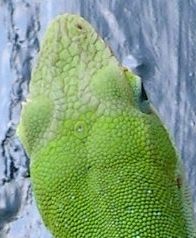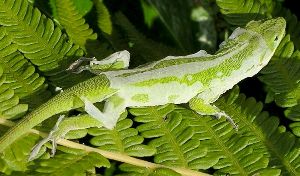Garden Dragons
by Valerie (August 16, 2000)
revised November 16, 2003
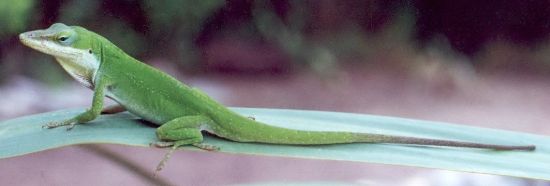  As we gradually planted everything from grass to flowers to trees, more animals started to visit, but I was always hoping for anoles: those slender green or brown lizards that prefer thick vegetation. As we gradually planted everything from grass to flowers to trees, more animals started to visit, but I was always hoping for anoles: those slender green or brown lizards that prefer thick vegetation.
Green anoles (Anolis carolinensis) are one of about 200 species in the Americas, and are the only species native this far north (there are other species in Florida, but they have been imported). Eventually, an anole showed up in our yard, and from that time they have increased non-stop, thriving in the variety of shade and sunny gardens, appearing everywhere from on the fences and compost bins to the trees, as well as in the cactus and wildflower gardens. Green anoles are very arboreal and rarely spend much time on the ground, preferring to climb about in the vegetation, or even on the house. I once found one caught by the skin of its neck on a hook-spined cactus (I released it unharmed), but they can usually negotiate cactus spines with dexterity. They also need appropriate places to lay their eggs, which they bury in loose or sandy soil, and which is at a premium in our area. From the locations of most of the hatchling lizards I see, they prefer only about four spots in our yard, including the pot containing a very large asparagus fern. The newly hatched anole here still has a bit of white egg scum clinging to it as it surveys its world for the first time from the vantage point of the asparagus fern foliage.
Anoles are superb predators and are constantly on the lookout for insects. Even when a lizard is watching me, it might suddenly lunge at a fly that settles too close, and they often hit their mark. While small insects seem to be the preferred victims, it is amusing to watch an anole trying to swallow larger prey, such as moths or butterflies. They are persistent, and I've never seen one give up, even if the insect they are swallowing is longer than their head. They finally manage to stuff it down.
All summer long the young anoles are evident as they seek out their own territories, gradually growing in size. The males are slightly bigger than the females and sometimes have fierce territorial disputes. We have watched two males battling like tiny dinosaurs over some prime real estate and they can actually draw blood. They bite each other, each one trying to grasp the other's head in its jaws. At any given time, the two lizards are not the same color, since one of the factors affecting their hue seems to be emotional and the winner is always greener than the loser. Of course, the "winner" can change from one moment to the next. The two pictured at right with their jaws locked are on the inside of one of the compost bins. The larger one on the bottom actually has a more advantageous grip on the other's head (and therefore is green). At the end of the fight they released each other and both were bruised but alive.
Their ability to change color between green and brown has given the anoles their common name of "chameleon;" however, they are more closely related to iguanas than the prehensile-tailed, long-tongued slow lizards of Africa. The color changes are caused by hormones and can be triggered by temperature, background color or mood. Cooler temperatures cause the lizards to usually be brown, and there are two types of brown, with the darkest being when they are really cold. A lighter brown color is evident when the anoles are on the bark of a tree or other dark background. The lizards are green when they are very warm, or in green vegetation. Newborn anoles always seem to be a gray color instead of green or brown, but they soon acquire the ability to change to the other hues just like the adults. The female lizard (with a belly distended by eggs) pictured to the right is mostly brown but has a bright green patch, which sometimes happens when the lizard has been leaning against something or been only partly in the sun. In this case, she was probably touching one of the wet leaves. As mentioned earlier, anoles change their color for emotional reasons as well, with lizards involved in disputes donning green for "winner" and brown for "loser." An interesting related color mix is found when the lizards mate: the female is always brown while the male is green. This can probably be analyzed to the extreme in anthropomorphic terms.
Although most of the time the anoles attempt to stay hidden, both from their prey and their predators, the males certainly take a lot of chances when defending territory or trying to entice the females. Birds are a major enemy and I have seen anoles with missing tails, wounds, and even holes in their sides, that could easily have been caused by a bird's beak. One habit that makes for lost tails seems to be the way anoles will perch upsidedown while hunting. Their tail sticks up in the air and often flips back and forth like a cat and I'm always tempted to grab it when I see it sticking over the edge of a fence or side of a leaf. I never do, but I'm sure that birds do not hesitate. The anoles can regrow their tail, like many lizards, but the new tail part lacks bones, often has a deformed look, and usually keeps a constant grayish brown color. The two photos shown at left are of the same juvenile, taken a couple months apart and illustrating the regrowth of the tail.
Many lizards have a strange feature on the middle of their head called the parietal eye. This is a photosensory organ that connects neurologically to the pineal body which is located in the brain. Even humans have a pineal body, but they lose it after childhood. In anoles, the parietal eye is functional only in hormone production and thermoregulation; the "eye" contains a lens and retina but cannot produce images. It does sense dark and light, though. The actual organ is covered by a clear scale on the lizard's head and it is not always easy to see on all individuals. The one pictured at right is particularly obvious.
Like snakes, anoles shed their skin periodically as they grow. But unlike snakes, which slip out of their skin in one piece, the lizards' skin comes off in tatters and shreds, which are sometimes then eaten by the individual. It seems that when prey is abundant, the lizards don't bother eating the skin, but do pull it off when it becomes bothersome to them. The green anoles don't seem to mind being watched as long as we don't get close enough to be threatening. They will usually look me straight in the eye, as if to see what I'm up to, then go about their business of hunting insects or sleeping. These active and attractive lizards are one of our favorite garden inhabitants. |
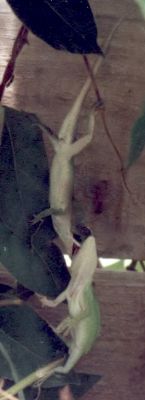
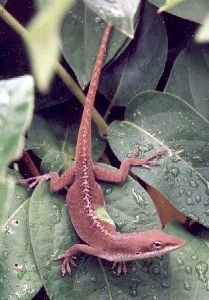

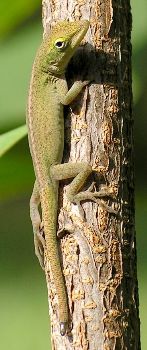

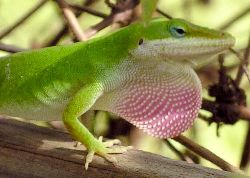 While captive anoles can live up to seven years, the males in our yard don't seem to live more than a couple of years, probably partly due to their visually obvious antics. When they are feeling particularly aggressive, they will even threaten humans with their large, red dewlap that they can open and close at will. This gesture is often accompanied by the lizard bobbing up and down, sort of like doing push-ups. Of course, the reason that the males hold territories is to lure females to mate. Being diurnal, these lizards are easily observed as they go about all their activities, including the most intimate ones.
While captive anoles can live up to seven years, the males in our yard don't seem to live more than a couple of years, probably partly due to their visually obvious antics. When they are feeling particularly aggressive, they will even threaten humans with their large, red dewlap that they can open and close at will. This gesture is often accompanied by the lizard bobbing up and down, sort of like doing push-ups. Of course, the reason that the males hold territories is to lure females to mate. Being diurnal, these lizards are easily observed as they go about all their activities, including the most intimate ones.
